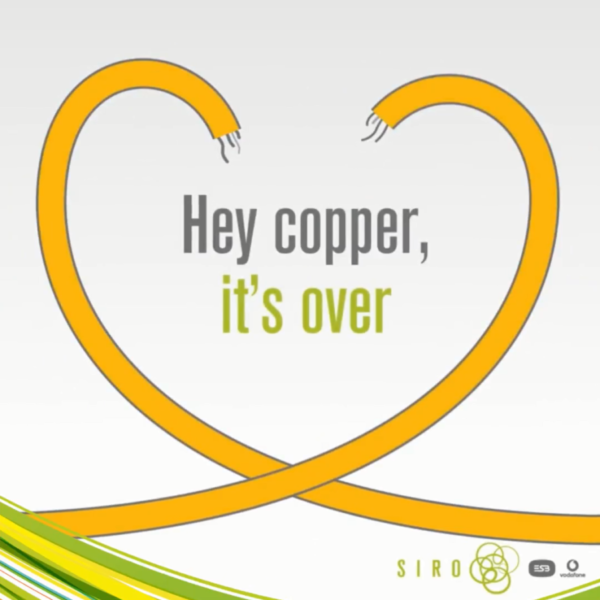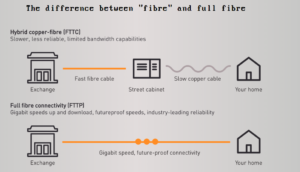Break Up with Copper - Gimme Fibre

The speed of your broadband connection largely depends on the journey the signal has to take to and from your router. There are two main technologies used in fibre-optic broadband: Fibre-to-the-cabinet (FTTC) which still uses copper at some points in the network, and Fibre-to-the-home (FTTH) with 100% fibre-optic cables. But which is best? And which is a dying technology?
FTTC versus FTTH
Currently the most used technology in Ireland, Fibre-to-the-Cabinet generally delivers speeds of up to 100 Megabits per second (Mbps). The downside is the last few feet between the telephone exchange cabinet on the street and the router in your house. All that fibre-optic, light-speed goodness is lost on the last stretch of copper wire used to connect your house to the exchange. Copper is good for old school landline calls, not so good for superfast broadband signals. It literally slows the signal right down. While 100 Mbps is the maximum speed, the speed you get could be much lower depending on the distance between your home and the cabinet.
SIRO is a Fibre-to-the-Home connection. This means you never lose the speed of fibre-optics – an incredible 1 Gigabit per second (Gbps). We build this network along the existing ESB lines – the fibre cables run directly to your router inside your house with no loss of signal.
Reliability
Fibre-optic cables are not affected by environmental factors than can weaken signals over copper cables. For example, the signal on a copper wire drops massively over just two kilometres, whereas fibre-optic cables over the same distance is extremely reliable. And, unlike copper, fibre-optic cables are extremely resilient to heat, humidity and extreme weather conditions, making this the last broadband connection you’ll ever need.
Security
Fibre-optic cables don’t carry electricity, so they don’t radiate signals that can be tapped. Copper uses electricity and therefore is open to be tapped, which can cause the entire system to fail. A broken or damaged fibre-optic cable can be identified very quickly. A copper cable can short completely or even go on fire if it is damaged, old or worn.

Source: Coppersaurus
It is important to recognize the distinction between FTTC and FTTH – between a copper-based and a full fibre connection. Very often, this line is blurred due to confusing advertising messages – currently there is little differentiation between part-fibre and full-fibre networks in broadband marketing. The good news is that the Advertising Standard Authority of Ireland (ASAI) has released specific guidelines requiring broadband providers to specify if their product is 100% Fibre, Part Fibre or Full Copper. This gives the end consumers the information, clarity and transparency they so require to make a fully-informed broadband decision.
SIRO 100% Fibre – The Most Powerful Broadband in Ireland
FTTH, the technology powering SIRO broadband, has been widely recognised as the only future proofed solution and the gold standard of broadband technology. But what exactly does it mean for the end consumers?
As discussed, with an FTTC connection, the longer the copper cable used, the more bandwidth you lose. With SIRO, there is no discernable loss over the distance from the cabinet to the router in your home. This opens up unlimited possibilities for home entertainment and remote working.
For the avid gamers, SIRO will transform the entire gaming experience, with extremely low latency and jitter level, little to no packet loss and lightning fast download speeds of 1 Gbps. For the movies enthusiasts, SIRO lets you download a 25GB HD movie in 3 minutes, compared to 30 minutes on a FTTC 100 Mbps connection (FTTH Council Europe). For the remote workers, imagine the ability to send and receive emails instantly, download large files in seconds, or video-call without lagging or buffering.
For small and medium businesses all over Ireland, SIRO best-in-class 100% fibre connectivity offers industry-leading speed and reliability – which enables you to worry less about whether you’ll be able to send that email to your client or get your contactless payment to work, and more on the actual strategic running of your business. Find out more about SIRO for Business.
Copper – the Dying Technology
There are many factors pointing towards the inevitable demise of copper technology. Consumers have increasingly realised the benefits of fibre: more Irish consumers than ever are switching to FTTH – the annual growth rate of FTTH is 115% -the fastest growth among all broadband subscription types, while copper connections have declined by 17.3% (Comreg quarterly data, Q1 2019). Following the regulation by the ASAI, we can expect an even stronger shift going into 2020 and beyond, as consumers will be able to tell whether it is fibre or copper they’re buying.
All over Europe, the battle against copper, and the call for a ‘copper switch-off’ is intensifying. In fact, a full copper switch-off has been found to be a win-win with numerous benefits for both consumers and operators. Soon, fibre-optics will completely replace copper cables in both long and short-haul networking – and copper will be truly a thing of the past. So why not future proof your homes or business today and check if your address is connectable to SIRO?
